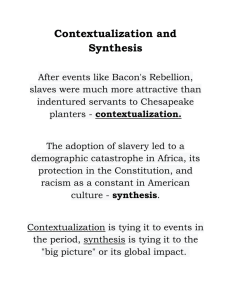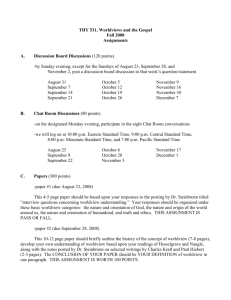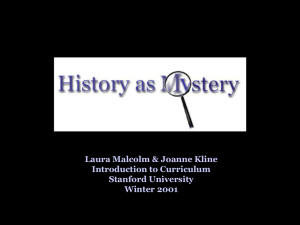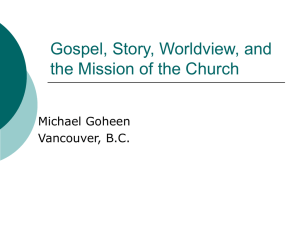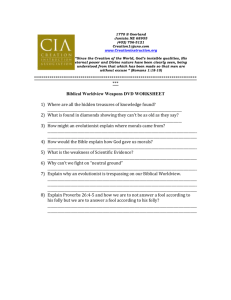CLASH OF CULTURES
advertisement
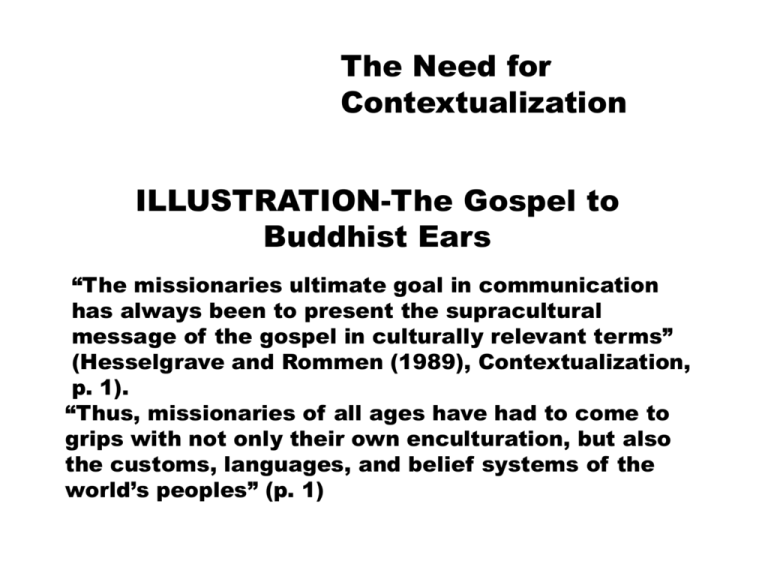
The Need for Contextualization ILLUSTRATION-The Gospel to Buddhist Ears “The missionaries ultimate goal in communication has always been to present the supracultural message of the gospel in culturally relevant terms” (Hesselgrave and Rommen (1989), Contextualization, p. 1). “Thus, missionaries of all ages have had to come to grips with not only their own enculturation, but also the customs, languages, and belief systems of the world’s peoples” (p. 1) Sharing your faith with a Buddhist • Buddhists emphasize orthopraxis not orthodoxy. This means that we need to be concerned about the social implications of the message we are sharing. • The foundation of a witnessing relationship with anyone is a relationship. • A relationship with people provides the interpretive context for understanding what we are saying. • View sharing the Gospel as a process and not a point in time event. • Bring issues of faith to the forefront of the relationship. Don’t be friends and then suddenly surprise people with a Gospel presentation. Let you faith be a natural part of your life. Sharing your faith with a Buddhist • People believe what they overhear more than what they are told directly. Expose Buddhists to the witness of the community. Let them overhear of God’s grace at work in people’s lives. • Make witnessing to Christ a dialogue and not just a monologue. • Ask questions about what they believe and practice. • Raise questions that are issues for them. In John 4 the woman raised a question that was important in her social setting. • Learn about Buddhism in order to anticipate objections that they may have and build this into your sharing of the content of the Gospel. Sharing your faith with a Buddhist • Buddhist people come to faith through experiencing Christ and not through verbal presentations alone. Bring prayer into your encounters with Buddhists. Pray with them for things that are happening in their life and invite them to pray. • Pray for Buddhists to bind the work of the enemy in their lives. • Build discipleship into evangelism. Let them know what is expected and what the Christian life is like. • Utilize small group and larger group events to expose people to personal testimonies and the Gospel message. • Tools-The four pillars of the Gospel, The Hand of Faith, the Five Principles for a Christian Life TWO POTENTAIL HAZARDS IN GOSPEL COMMUNICATION 1. The perception of the communicators own cultural heritage as in integral part of the gospel. 2. Syncretistic inclusion of elements of the receptor culture which alter/eliminate aspects of the message upon which the integrity of the gospel depends. The need for contextualization is grounded in the complexity of communication S message-meaning[filters] <encodes> sends receives[filters] <decodes>messagemeaning R What happens in communication? Outside/Inside we receive a sign, this calls up a referent (tree, car, house). Attempting to interepret or find meaning in the sign we file a reference in our brain. Then we verbalize or assign a symbol to it. Sign>>>referent>>>reference>>>symbol The Semantic Triangle reference The fundamental semantic problem is that there is no direct connection between the symbol and the referent. The word is not the thing. symbol ………………. referent Insights from Modern Communication Theory Meaning is in people, in sources and receptors, not in words or events or things. Words as such have no meaning. The source of a message entertains an idea which is expressed in the words and phrases of a language code, but the meaning stays in the source’s head. The receptor is stimulated by the words and phrases (the message) and decodes it into certain meanings, corresponding more or less to the meaning entertained by the source. But the meaning is to be located in the two minds not in the message. (Hesselgrave and Rommen, p. 188) Hesselgrave and Rommen’s critique, “Pressed too far, to say that there is no meaning in words is like saying that there is no value in stocks or bonds or a one-thousand dollar bill. There is no inherent, intrinsic value in them, but they have an imputed, invested value. Otherwise, people would not rob banks (p. 194). •E. B. Tylor 1871 Culture is “that complex whole which includes knowledge, belief, art, morals, law, custom, and any other capabilities and habits acquired by man as a member of society.” •Marvin Mayers…Culture is learned and shared attitudes, values, ways of behaving and material artifacts. •Kottak (1991, p. 17 in Borofsky p. 3) Culture as that which is “distinctly human; transmitted through learning; traditions and customs that govern behavior and beliefs.” •Bohannan (1992, p. 22 in Borofsky p. 3) Culture is “the capacity to use tools and symbols.” •Keesing (1981, p. 509 in Borofsky p. 3) Culture “is the system of knowledge more or less shared by members of society.” Kroeber and Kluckhohn (1963 in Borofsky p. 3) explored over 150 definitions of culture in Culture: A Critical Review of Concepts and Definitions and summarize their own in this lengthy definition: “Culture consists of patterns, explicit and implicit, of and for behavior acquired and transmitted by symbols, constituting the distinctive achievement of human groups, including their embodiments in artifacts; the essential core of culture consists of traditional…ideas and especially their attached values; culture systems may, on the one hand, be considered as products of action, on the other as conditioning elements of further action.” •Culture consists of many systems of organized behavior governed by traditional standards and rules specifying how people are supposed to act. •It includes ideas, values, goals, as well as the material products created. •Cultures develop distinctly from one another, but basic human needs (food, shelter, friendship etc.) cause cultures to resemble one another closely. Cultures develop institutions to fulfill basic human needs and govern relationships. •Culture is learned, and language is the social vehicle by which it is shared, sustained, and preserved. •All cultures are subject to continuous change. •Within cultures are distinct groups of subcultures. Butler and Martorella (1979), Sociology: A Basic Course What is done? What is good or best? What is true? What is real? WORLDWIEW BELIEFS VALUES BEHAVIOR Accessed on August 26, 2005 at www.theculturalcommission.o rg/education What In The World Is A Worldview? Worldview Definitions Worldview Scriptures Worldview Analogies Worldview Checklist • Organized • Complete • Non-contradictory • Livability • Consequences Worldview Definition A worldview is all the presuppositions and assumptions you bring to bear on every decision you make in life. Worldview Scriptures 2 Corinthians 10:3-5 3For though we walk in the flesh, we do not war according to the flesh. 4For the weapons of our warfare are not carnal but mighty in God for pulling down strongholds, 5casting down arguments and every high thing that exalts itself against the knowledge of God, bringing every thought into captivity to the obedience of Christ. Acts 17: The Classic “Worldview in Action” Scripture • Act 17:22, “Then Paul stood in the midst of the Areopagus and said, "Men of Athens, I perceive that in all things you are very religious; 23 for as I was passing through and considering the objects of your worship, I even found an altar with this inscription: TO THE UNKNOWN GOD. Therefore, the One whom you worship without knowing, Him I proclaim to you…” Worldview Analogies Worldview lenses Worldview Analogies Our worldview is the rails on which our lives run. Worldview Analogies Francis Schaeffer said that we are all worldview missionaries. Organizing Your Worldview System 1 • Creation - How did we get here? • Fall – What has gone wrong? • Redemption – What can be done about it? Organizing Your Worldview System 2 • God • Metaphysics • Epistemology • Ethics • Human Nature 5 Centripetal Tendencies 1. Relatively durable in the individual. 2. Emotional and motivational force. 3. Relatively durable historically, reproduced generation to generation. 4. Relatively thematic in the sense that understanding may be repeatedly shared in a wide variety of contexts. 5. More or less widely shared. 4 Centrifugal Tendencies 1. Changeable in person, across generations. 2. Unmotivating. 3. Contextually limited. 4. Can be shared by relatively few in a society Quinn and Strauss (1997), A Cognitive Theory of Cultural Meaning How Do You Account for the Fact that Both of These Situations are True? Culture as a thing (essentialist, reification) Bounded, timeless, unchanging..The Culture of X Culture as an invention, constructed (Postmodern) Culture as Public Meanings (GeertzInterpretivist) Culture as shared mental representations-cognitive anthropology Anthropologists have conceptualized culture in many ways: •traits •integrated configurations •constellations of symbols and meanings •symbolic templates •a web of meanings •taxonomic trees •measurable units of behavior •a collection of material artifacts •systems of knowledge, sets of beliefs and values •strategies for reaching a goal •a series of divers discourses Culture is best conceived as a very large and heterogenous collection of models…They exist both as public artifacts ‘in the world’ and as cognitive constructs ‘in the mind’ of members of a community. Personal mental models-illustration…neighborhood maps Conventional models-part of the stock of shared cognitive resources of my own community…illustration Star Spangled Banner Mental models are creative and adaptive simplifications of reality…they abstract and schematize relevant information (reduce details and highlight salient features). It is part memory, part invention. An important difference between personal and cultural models “Cultural models are constructed as mental representations in the same way as any mental models with the important exception that the internalization of cultural models is based on more socially constrained experiences than is the case of idiosyncratic models. Cultural practices that constrain attention and guide what is perceived as salient are not left open to much personal choice but are closely guided by social norms” Defining Contextualization Contextualization, culture and theology had a simultaneous beginning…when the silence was broken by the voice of God, communication commenced between man and God. In more recent times there has been an enlarged concept of context and deepened understanding of culture. “A new word was needed to denote the ways in which we adjust messages to cultural contexts and go about the doing of theology itself. That new word is contextualization” (Hesselgrave and Rommen, p. 28). The term “contextualization” first appeared the 1970’s in Protestant conciliar circles. “To its originators it involved a new point of departure and a new approach to theologizing and to theological education: namely, praxis or involvement in the struggle for justice within the existential situation in which men and women find themselves today” (Hesselgrave and Rommen, p. 32). Evangelicals adopted the word but not the meaning or method… Making concepts or ideals relevant, translating the Gospel into a meaningful form, discovering legitimate applications of the gospel in a given situation... “This brings us to the heart of the problem for evangelical. There is not yet a commonly accepted definition of the word contextualization.” (p. 35). Contextualization Specifically, I propose that our contextualization agenda include (at a minimum) seven critical areas: Bible translation, language, evangelism, church planting, worship and music, theology and leadership training. -Harley Talman -International Journal of Frontier Missions 21:1 Spring 2004.6 Contextualization: The Theory, the Gap, the Challenge Darrell L. Whiteman International Bulletin of Missionary Research— January 1997 Contextualization captures in method and perspective the challenge of relating the Gospel to culture. Contextualization: The Theory, the Gap, the Challenge Darrell L. Whiteman International Bulletin of Missionary Research— January 1997 First Function Contextualization attempts to communicate the Gospel in word and deed and to establish the church in ways that make sense to people within their local cultural context, presenting Christianity in such a way that it meets people’s deepest needs and penetrates their worldview, thus allowing them to follow Christ and remain within their own culture. Contextualization: The Theory, the Gap, the Challenge Darrell L. Whiteman International Bulletin of Missionary Research— January 1997 Second Function Another function is to offend—but only for the right reasons, not the wrong ones. When the Gospel is presented in word and deed, and the fellowship of believers we call the church is organized along appropriate cultural patterns, then people will more likely be confronted with the offense of the Gospel, exposing their own sinfulness and the tendency toward evil, oppressive structures and behavior patterns within their culture. Contextualization: The Theory, the Gap, the Challenge Darrell L. Whiteman International Bulletin of Missionary Research— January 1997 Third Function The third function is to develop contextualized expressions of the Gospel so that the Gospel itself will be understood in ways the universal church has neither experienced nor understood before, thus expanding our understanding of the kingdom of God. Different Starting Points Lead to Different Kinds of Contextualization •Emphasizes the supracultural nature of the biblical Gospel. •Recognizes that biblical revelation is not acultural, but that God oversaw the process so that his message was transmitted. •“Their emphasis is on taking the apostolic faith ‘once for all entrusted to the saint’ (Jude 3) and contextualizing (translating, interpreting, adapting, applying) that faith (body of truth) to the people of a respondent culture in such a way as to preserve as much of its original meaning and relevance as possible” (Hesselgrave and Rommen, p. 149). Authenticity-deals with God’s revelation. Faithfulness to the authority and content of the will of God as revealed in creation, conscience and Scripture. Authenticity does not guarantee the message is meaningful and pursuasive to the respondents. Relevance-speaks of effectiveness. It is communication that grows out of understanding our respondents in their particular context and the work of the Holy Spirit in us an them. Christian Contextualization • The attempt to communicate the message of the person, works, Word and will of God in a way that is faithful to God’s revelation… • …and that is meaningful to respondents in their respective cultural and existential contexts. • It is both verbal and nonverbal and has to do with theologizing, Bible translation, interpretation and application, incarnational lifestyle, evangelism, Christian instruction, church planting and growth, church organization, worship style etc. Is not monocultural (ethnocentric) nor pluralistic (cultural relativity). It seeks to enable people in one culture to understand messages and ritual practices from another culture with a minimum of distortion. It is based on a critical realist epistemology It takes historical and cultural contexts seriously It sees contextualizaton as on ongoing process Paul Hiebert (1994) Anthropological Reflections on Missiological Issues Contextualization Involves Two Major Tasks • Task 1 Interpretation and Decontextualization (Revelation, Interpretation, Application). • Task 2 Contextualize the message to communicate it effectively to respondents in the target culture (7 Dimension Paradigm) Lingenfelter’s Synthesis: Pluralism, Biblical Contradiction and Transformation 1. Cultural relativity-pluralism (with a low view of culture, tainted by sin). Varieties of worldviews, relationship of social environment and worldview. 2. Biblical absolutism-commitment to the truth and authority of Scripture. 3. Biblical contradiction-”How does the Gospel contradict what I think, what I believe and how I live?” Thinking theologically apart from worldview. 4. Transformation-living transformed lives within our cultural environments. Critical Contextualization •Exegete the Culture-uncritically gather information. •Exegete Scripture-what it meant. •Build the Hermenuetical Bridge-translate the Biblical message into the cognitive, affective, and evaluative dimensions of another culture. Without the bridge you have a distorted view of the Gospel. •Critical Response-evaluate customs in light of the new biblical understanding and make a decision. •Develop new contextualized practices. •Check against syncretism-the church as a hermeneutical community. IDEAS FOR EXEGETING CULTURE • The ethnographic interview-Notes from Spradley • Open ended-interviews • Domain Analysis-Free Recall Listing • Pile Sorts • Paired or Triadic Comparisons • Gathering Proverbs (stan@gmi.org “Listen first, Speak Later” CONTEXTUALIZING THE GOSPEL FOR BUDDHIST EARS •Finding points of entry-sowing/reaping, desire, all religions equally good •Knowing what people think-anticipating objectionsJesus and bad karma •Using illustrations as windows on truth-finding multiple illustrations for each major concept •Correcting misunderstandings as the base for sharing the Gospel •Good contextualization of the message cannot overcome bad ecclesiology-the power of a life as a contextualized message Worldview Culture patterns perception of reality into conceptualizations of what reality can or should be, what is to be regarded as actual, probable, possible, and impossible. These conceptualizations form what is termed the “worldview” of the culture. The worldview is the central systematization of conceptions of reality to which the members of the culture assent (largely unconsciously) and from which stems their value system. The worldview lies at the very heart of culture, touching, interacting with, and strongly influencing every other aspect of the culture. Kraft, C. (1979). Christianity and Culture: 53 Forms, Functions, Meanings, and Usage 1. The forms of a culture are the observable parts of which it is made up. These are the customs arranged in patterns or the products of those customs. Many cultural forms are conceptualizations of material items; most are conceptualizatioins of nonmaterial items. Kraft, C. (1979). Christianity and Culture: 64 Forms, Functions, Meanings, and Usage 2. Each of the forms of a culture is used…by the people of that culture to serve particular functions. Certain of these functions are general, universal functions, relation to basic human needs that every culture must meet. Others are more specifically related to nonuniversal, individual, and group concerns. Kraft, C. (1979). Christianity and Culture: 65 Forms, Functions, Meanings, and Usage 3. One of the most important functions served by every cultural form is to convey meaning to the participants of a culture. The meaning of a cultural form consists of “the totality of subjective associations attached to the form” (Luzbetak 1963:139). In many ways “culture is communication” (Hall 1959). Kraft, C. (1979). Christianity and Culture: 65 Forms, Functions, Meanings, and Usage 4. Closely interrelated to function and meaning is the matter of how a cultural form is used. This consideration, more than others, makes explicit the active part that human beings take in the operation of culture. The forms of culture are relatively passive in and of themselves. Kraft, C. (1979). Christianity and Culture: 66 Principles in Contextualization “Is this practice usable within Christianity or does it express an allegiance that is incompatible with faith-allegiance to God through Christ?” Perhaps the following five principles will be both helpful and in accord with the insights generated so far: Kraft, C. (1979). Christianity and Culture: 93 Principles in Contextualization 1. As a first step toward evaluation, every cultural system should be sized up in terms of its own ideals, not those of some similar system in another culture. Kraft, C. (1979). Christianity and Culture: 93 What problems does this system set for itself and how well do its forms fit the functions/needs of which the people and their culture as a whole are aware? Principles in Contextualization 2. In evaluating any aspect of any culture (including our own) it is important to be constantly aware of the fact that the pervasiveness of sin is a universal. Every culture is less than totally adequate. Kraft, C. (1979). Christianity and Culture: 93 Principles in Contextualization 3. Even with the benefit of the biblical revelation, Paul felt constrained to state that “what we see now is like the dim image in a mirror . . . What I know now is only partial . . .” (1 Cor. 13:12 TEV). It is therefore highly unlikely that we understand as much about the specific of how God seeks to work in culture (even our own) as we often think we do. Kraft, C. (1979). Christianity and Culture: 93 Principles in Contextualization 4. We should recognize, as anthropologists point out, that a people’s religious system does serve several extremely important horizontal functions whether or not it adequately fulfills the necessary vertical functions. Kraft, C. (1979). Christianity and Culture: 93 Principles in Contextualization 5. We should recognize the universal need for the fulfilling of the function of relating human beings to God. All people need this relationship with God through Christ. Kraft, C. (1979). Christianity and Culture: 94 The need to experience it, however, without the necessity of converting from their particular set of cultural forms to, for example, our cultural forms (see Acts 15). For our forms are not prerequisite (or even necessarily the best) for adequately expressing the fulfillment of this vertical function in their culture.
